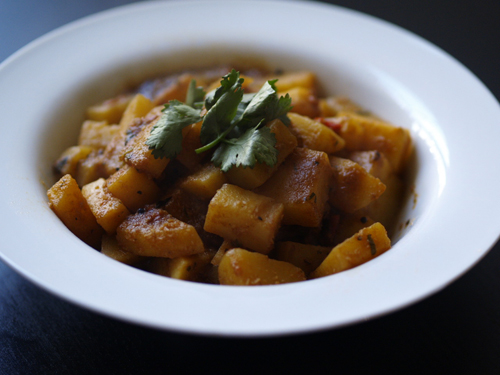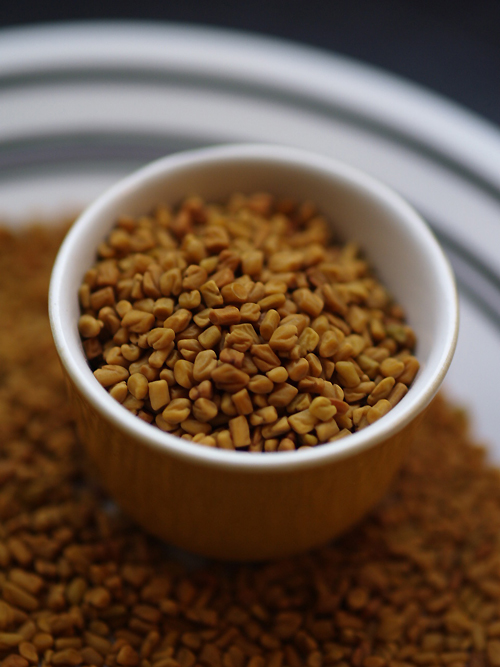In India, the leaves of the fenugreek plant are used as a fragrant herb when dried and used as greens in their fresh state. The bitterness of the seed is reflected in the fresh leaves. They are very fragrant when they are dried. In the dry form, fenugreek leaves are used in curries and paired with vegetables like peas. They pair especially well with cream-based recipes. The seeds are like a more humble cousin. They too are used in different kinds of curries and in combination with various vegetables like okra and eggplant. The difference is that the seed will form the base of the recipe while the herblike leaves will be sprinkled on top of a dish towards the end of cooking.
Potatoes with coconut and fenugreek seeds
While several dishes use fenugreek seeds, either as part of a spice mix or on its own, the seeds are the star of this recipe along with the very versatile potato. It would be hard to define the roots of this dish. It falls under some semblance of western Indian cooking, but I think the credit lies with my mother-in-law, from whom I got the recipe. Were you to try to look for a similar vegetable recipe, you would most likely end up with several using fenugreek leaves. Like most Indian dishes, this one involves a combination of a few spices but they all come together in celebration of this unassuming seed, which is often relegated to a supporting role.

Serves: 3-4
Ingredients:
4 large yellow or red potatoes
1 cup grated coconut (fresh or frozen)
5 to 6 peppercorns
1/2 tsp tamarind paste
1 tsp black mustard seeds
1/4 tsp asafoetida
1/2 tsp fenugreek seeds
4 to 5 curry leaves
1/4 tsp turmeric powder
1/2 tsp red chilli powder
1 large tomato, diced
2 to 3 tbsp canola or vegetable oil
Salt to taste
Preparation:
1. Cut potatoes lengthwise into eighths.
2. In a food processor, grind together the coconut, peppercorns and tamarind paste.
3. Heat the oil in a deep pan. To this add the mustard seeds, asafoetida, fenugreek seeds and curry leaves.
4. When the mustard seeds and curry leaves start to splutter, add the potatoes and stir to coat.
5. Add the turmeric and chilli powders and toss the potatoes in it until evenly coated. Fry for a bit.
6. Add the coconut gravy. Stir together and cover the pan to allow the mixture to simmer for a short while.
7. Once the potatoes are just about cooked, add the diced tomato and stir. Add salt.
8. Turn up the heat to bring the mixture to a rolling boil. Then turn the heat down to simmer for five minutes before serving.
Serve with rice or bread.
Notes:
Fenugreek seeds should be lightly roasted. They are horribly bitter and hard to eat when they are subjected to a dark roast. The seeds are readily available in any store that sells spices. Certain grocery stores, like Safeway may sell it in its powdered form. Indian chilli powder is purely ground up dried chillis. That (as well as asafoetida) are available inexpensively in Indian stores. Curry leaves should be available in their freezer section. A good thing to remember is that most Indian stores will sell spices at much more reasonable rates than other stores. Since they are widely used in Indian food, the spices there should also be fresher because of the rapid turnover.

